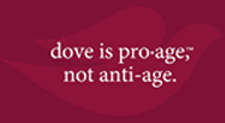A Contemporary Discourse of Western Beauty Ideals
An Introduction: What is ProAge?
Dove is an international chain of beauty products owned by the Unilever corporation, which was originally created in 1955 as a brand of soap bars. Dove has since evolved into an expansive line of products, ranging from deodorant to hair care, all of which are competitive fixtures in today's western beauty-consumer market. In 2004 Dove launched their Campaign For Real Beauty, which targeted a "mature female" audience. More specifically, the campaign was designed to attract women over fifty years old. Dove created the slogan "every girl deserves to feel beautiful just the way she is" in an effort to put a fresh spin on their new line of "mature female" beauty-care products. In reality this was just another assortment of typical anti-aging products, available to consumers in drugstores across America. The campaign's positive message of embracing the human aging process quickly translated into a highly lucrative line of products. In 2007 Dove launched the ProAge campaign as an extension to the Campaign For Real Beauty, hoping to generate more revenue from their "mature female" demographic. The ProAge line of beauty-care was so successful during its first year on the market, it has continued into 2008 as one of the lead advertising campaigns in the industry. Much like the Campaign For Real Beauty, ProAge asserts the notion of embracing the process of aging as a positive journey. The new campaign sends a more explicit message however, using "dove is pro-age, not anti-age" as one of the brand's main marketing slogans. The Dove brand continues to promote ProAge products through a unique discourse of the female beauty image that supposedly negates the hegemonic and traditional beauty ideals, found in mainstream western culture.
In order to articulate a coherent visual discourse from Dove's ProAge campaign, it is important to conduct a comprehensive study. This assessment of Dove's ProAge marketing campaign draws visual material from the mediums of print, television, and billboard advertising. In conjunction, several modes of visual analysis have been used on the path to understanding this evidence. The following images of each advertising medium have been analytically deconstructed and then rebuilt using the visual methodologies of semiotics, discourse analysis (I and II), psychoanalysis, and audiencing. Although these various methods of visual analysis can be addressed separately, they unanimously come together here to articulate ProAge's cohesive discourse regarding the female beauty image, while catering to the demands of Dove and the Unilever corporation.

|
HOME NEXT